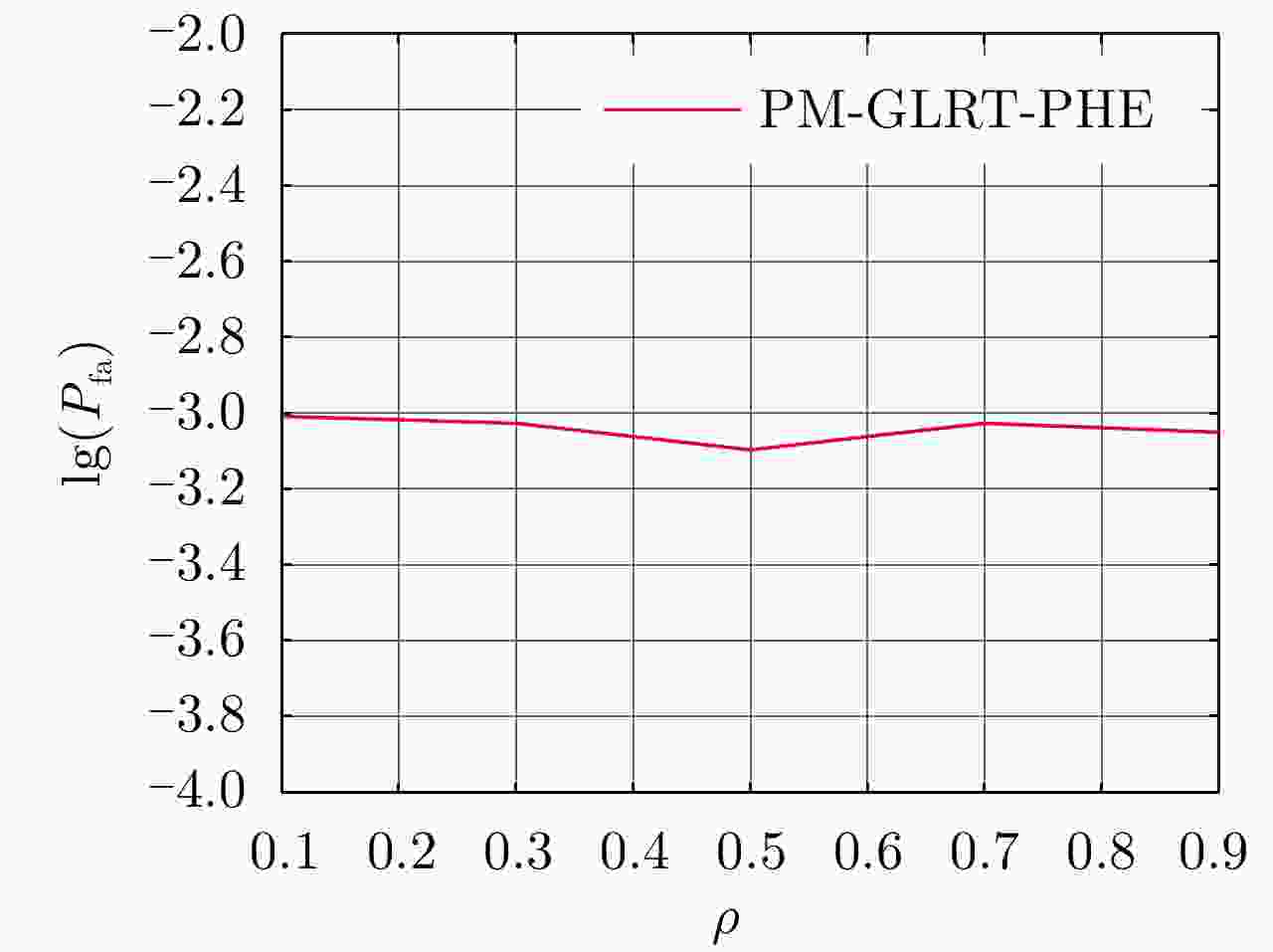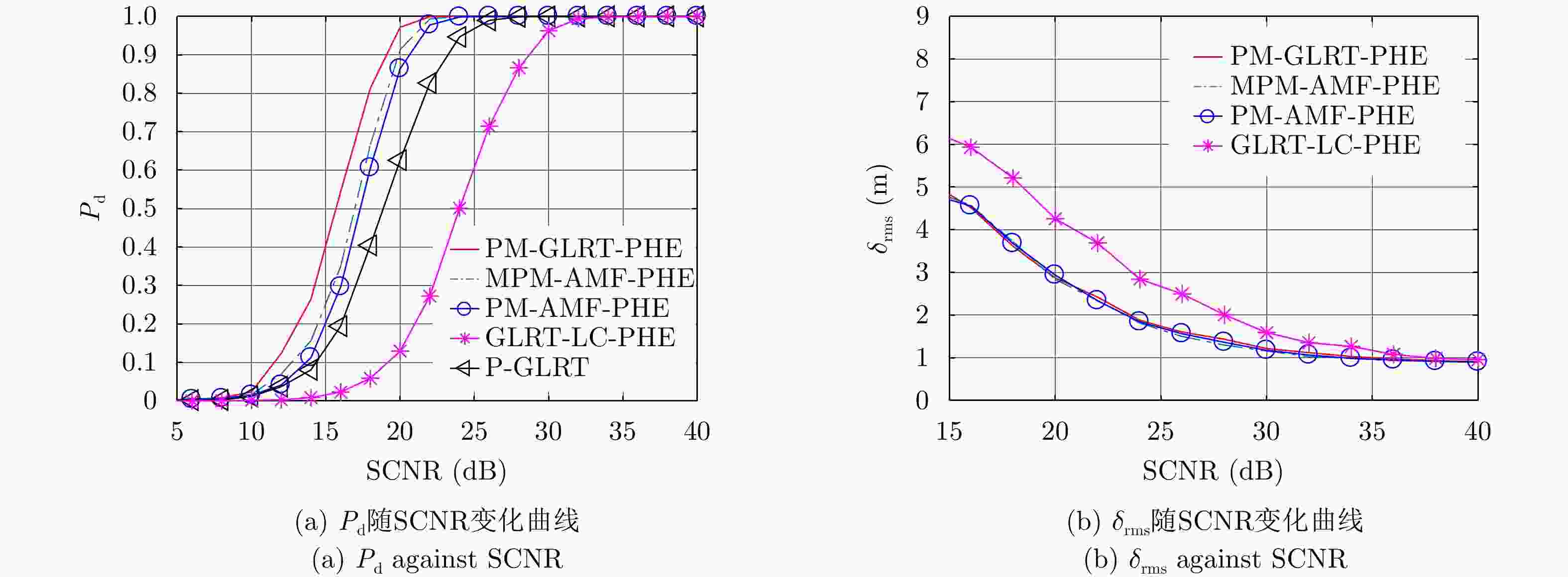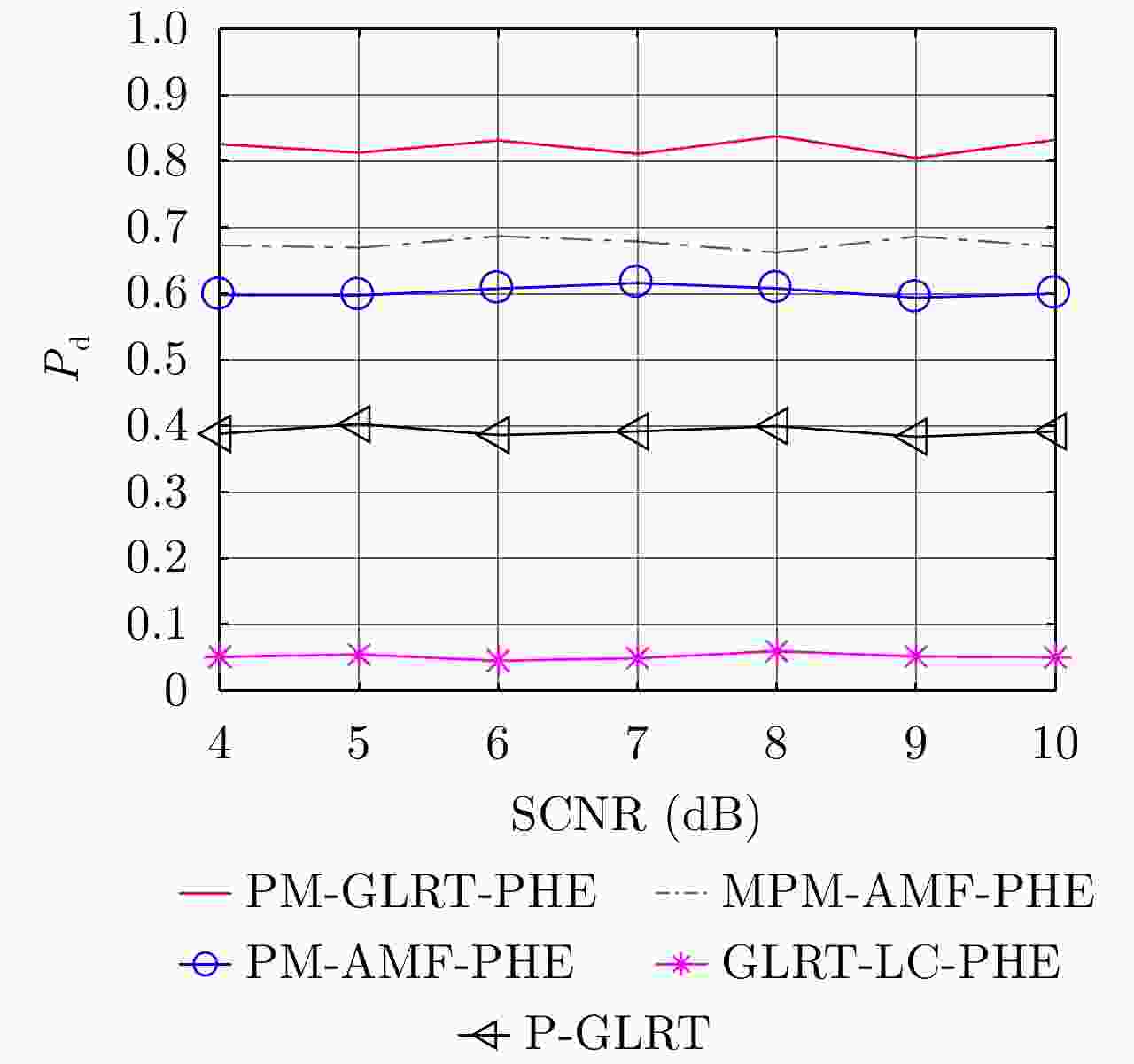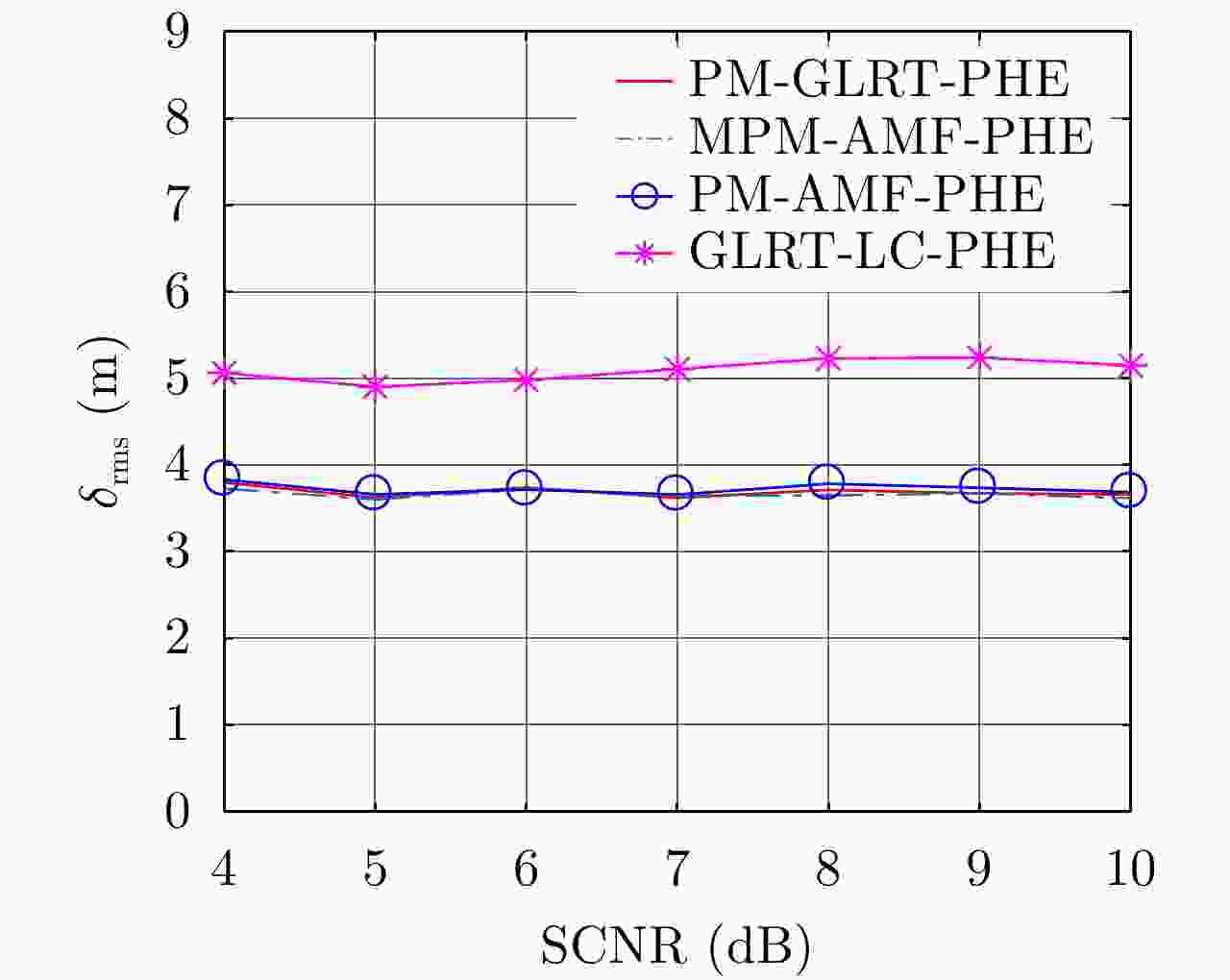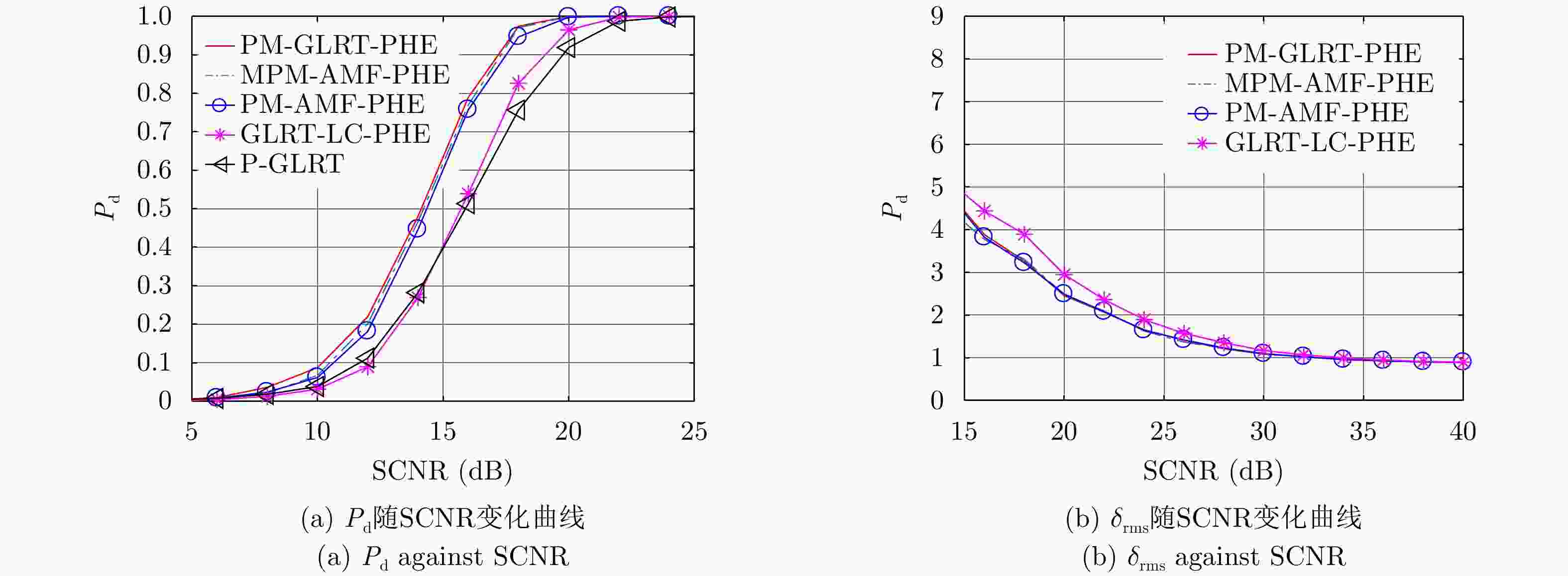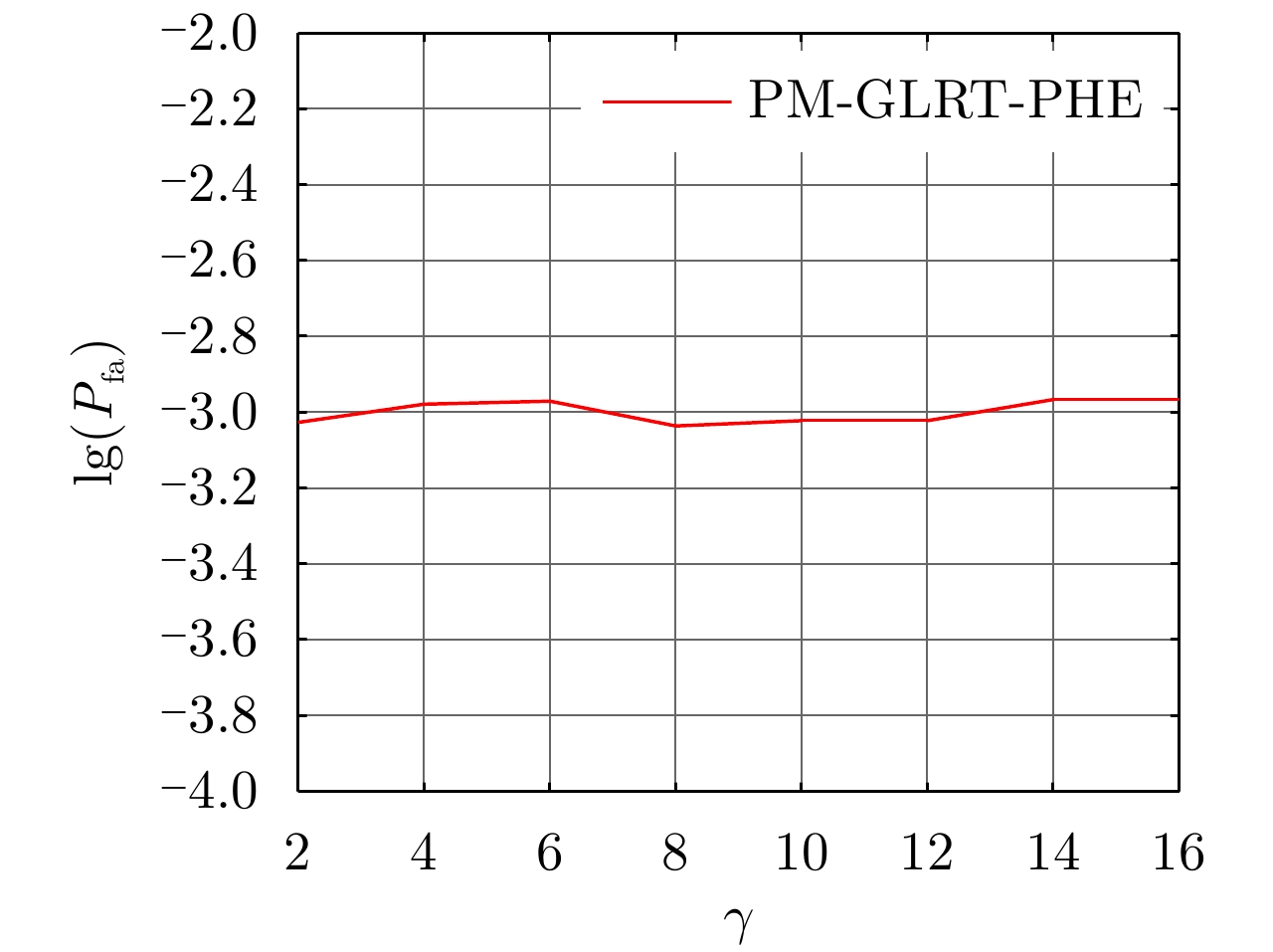Modified Generalized Likelihood Ratio Test Detection Based on a Symmetrically Spaced Linear Array in Partially Homogeneous Environments
-
摘要: 针对部分均匀高斯干扰环境下的点目标检测问题,该文基于广义似然比准则(GLRT)提出一种适用于空间对称线阵的修正GLRT检测方法。考虑到采样时存在的目标能量泄漏,在接收信号建模时采用目标能量泄漏采样模型弥补泄漏损失,并基于干扰协方差矩阵的斜对称结构降低对辅助数据的需求,最终联合待检测数据和辅助数据实现未知参数的估计,得到兼具有良好目标检测和距离估计性能的斜对称修正GLRT检测方法。仿真结果表明,该方法不仅在部分均匀环境下具有恒虚警特性,而且在辅助数据数量受限时,相比其同类型的检测方法具有1 dB以上的检测性能优势。Abstract: To address the problem of detecting point-like targets in a partially homogeneous Gaussian cluttered environment, we developed a modified Generalized Likelihood Ratio Test (GLRT) detection method based on a symmetrically spaced linear array that relies on a GLRT design criterion. Considering the target energy spillover during sampling, we use a spillover model of the target energy to decrease spillover loss. To establish the discrete-time signal mode, we use a persymmetric structure of the disturbance covariance matrix to reduce the requirement for auxiliary signals. Lastly, we estimate all of the unknown parameters based on a consideration of both primary and secondary data to derive the persymmetric modified GLRT detector, which has good target detection and range estimation performance. The performance assessment shows that the proposed method not only performs as a constant false-alarm-rate receiver in partially homogeneous environments but also guarantees superior detection performance relative to that of its competitors. In sample-starved environments, compared with other detection methods of the same type, it realizes a detection performance advantage greater than 1 dB.
-
表 1 不同场景下PM-GLRT-PHE的阈值
Table 1. Thresholds of PM-GLRT-PHE in different cases
仿真场景 干扰数量 干扰波达角度 阈值$\eta $ 场景1 0 0 2.0098 场景2 1 5° 2.0484 场景3 2 5°, 10° 2.0188 场景4 3 –15°, 5°, 15° 1.9873 场景5 4 –20°, –10°, 5°, 20° 2.0308 -
[1] BRENNAN L E and REED L S. Theory of adaptive radar[J]. IEEE Transactions on Aerospace and Electronic Systems, 1973, AES-9(2): 237–252. doi: 10.1109/TAES.1973.309792 [2] 王永良, 彭应宁. 空时自适应信号处理[M]. 北京: 清华大学出版社, 2000: 1–4.WANG Yongliang and PENG Yingning. Space-Time Adaptive Processing[M]. Beijing: Tsinghua University Press, 2000: 1–4. [3] 王永良, 刘维建, 谢文冲, 等. 机载雷达空时自适应检测方法研究进展[J]. 雷达学报, 2014, 3(2): 201–207. doi: 10.3724/SP.J.1300.2014.13081WANG Yongliang, LIU Weijian, XIE Wenchong, et al. Research progress of space-time adaptive detection for airborne radar[J]. Journal of Radars, 2014, 3(2): 201–207. doi: 10.3724/SP.J.1300.2014.13081 [4] KELLY E J. An adaptive detection algorithm[J]. IEEE Transactions on Aerospace and Electronic Systems, 1986, AES-22(2): 115–127. doi: 10.1109/TAES.1986.310745 [5] 韩金旺, 张子敬, 刘军, 等. 基于贝叶斯的高斯杂波背景下MIMO雷达自适应检测算法[J]. 雷达学报, 2019, 8(4): 501–509. doi: 10.12000/JR18090HAN Jinwang, ZHANG Zijing, LIU Jun, et al. Adaptive Bayesian detection for MIMO radar in Gaussian clutter[J]. Journal of Radars, 2019, 8(4): 501–509. doi: 10.12000/JR18090 [6] ROBEY F C, FUHRMANN D R, KELLY E J, et al. A CFAR adaptive matched filter detector[J]. IEEE Transactions on Aerospace and Electronic Systems, 1992, 28(1): 208–216. doi: 10.1109/7.135446 [7] LIU Jun, LIU Weijian, CHEN Bo, et al. Modified Rao test for multichannel adaptive signal detection[J]. IEEE Transactions on Signal Processing, 2016, 64(3): 714–725. doi: 10.1109/TSP.2015.2491892 [8] 刘维建, 王利才, 狄源水, 等. 自适应能量检测器及在失配信号检测中的应用(英文)[J]. 雷达学报, 2015, 4(2): 149–159. doi: 10.12000/JR14132LIU Weijian, WANG Licai, DI Yuanshui, et al. Adaptive energy detector and its application for mismatched signal detection[J]. Journal of Radars, 2015, 4(2): 149–159. doi: 10.12000/JR14132 [9] LIU Weijian, XIE Wenchong, and WANG Yongliang. Rao and Wald tests for distributed targets detection with unknown signal steering[J]. IEEE Signal Processing Letters, 2013, 20(11): 1086–1089. doi: 10.1109/LSP.2013.2277371 [10] CUI Guolong, KONG Lingjiang, YANG Xiaobo, et al. Adaptive polarimetric MIMO radar detection[C]. 2010 International Symposium on Intelligent Signal Processing and Communication Systems, Chengdu, China, 2010: 1–4. doi: 10.1109/ISPACS.2010.5704762. [11] LIU Jun, ZHANG Zijing, YANG Yun, et al. A CFAR adaptive subspace detector for first-order or second-order Gaussian signals based on a single observation[J]. IEEE Transactions on Signal Processing, 2011, 59(11): 5126–5140. doi: 10.1109/TSP.2011.2164073 [12] NITZBERG R. Application of maximum likelihood estimation of persymmetric covariance matrices to adaptive pro-cessing[J]. IEEE Transactions on Aerospace and Electronic Systems, 1980, AES-16(1): 124–127. doi: 10.1109/TAES.1980.308887 [13] 丁昊, 薛永华, 黄勇, 等. 均匀和部分均匀杂波中子空间目标的斜对称自适应检测方法[J]. 雷达学报, 2015, 4(4): 418–430. doi: 10.12000/JR14133DING Hao, XUE Yonghua, HUANG Yong, et al. Persymmetric adaptive detectors of subspace signals in homogeneous and partially homogeneous clutter[J]. Journal of Radars, 2015, 4(4): 418–430. doi: 10.12000/JR14133 [14] CASILLO M, DE MAIO A, IOMMELLI S, et al. A persymmetric GLRT for adaptive detection in partially-homogeneous environment[J]. IEEE Signal Processing Letters, 2007, 14(12): 1016–1019. doi: 10.1109/LSP.2007.906209 [15] GAO Yongchan, LIAO Guisheng, ZHU Shengqi, et al. Persymmetric adaptive detectors in homogeneous and partially homogeneous environments[J]. IEEE Transactions on Signal Processing, 2014, 62(2): 331–342. doi: 10.1109/TSP.2013.2288087 [16] WANG Yongliang, LIU Weijian, XIE Wenchong, et al. Reduced-rank space-time adaptive detection for airborne radar[J]. Science China Information Sciences, 2014, 57(8): 082310. doi: 10.1007/s11432-013-4984-5 [17] LIU Weijian, LIU Jun, HUANG Lei, et al. Performance analysis of reduced-dimension subspace signal filtering and detection in sample-starved environment[J]. Journal of the Franklin Institute, 2018, 356(1): 629–653. doi: 10.1016/j.jfranklin.2018.10.017 [18] LIU Weijian, XIE Wenchong, LI Rongfeng, et al. Adaptive detectors in the Krylov subspace[J]. Science China Information Sciences, 2014, 57(10): 102310. doi: 10.1007/s11432-014-5080-1 [19] FOGLIA G, HAO Chengpeng, FARINA A, et al. Adaptive detection of point-like targets in partially homogeneous clutter with symmetric spectrum[J]. IEEE Transactions on Aerospace and Electronic Systems, 2017, 53(4): 2110–2119. doi: 10.1109/TAES.2017.2680758 [20] YAN Linjie, HAO Chengpeng, ORLANDO D, et al. Parametric space-time detection and range estimation of point-like targets in partially homogeneous environment[J]. IEEE Transactions on Aerospace and Electronic Systems, 2020, 56(2): 1228–1242. doi: 10.1109/TAES.2019.2928672 [21] HAO Chengpeng, GAZOR S, ORLANDO D, et al. Parametric space-time detection and range estimation of a small target[J]. IET Radar, Sonar & Navigation, 2015, 9(2): 221–231. doi: 10.1049/iet-rsn.2014.0081 [22] DE MAIO A, ORLANDO D, HAO Chengpeng, et al. Adaptive detection of point-like targets in spectrally symmetric interference[J]. IEEE Transactions on Signal Processing, 2016, 64(12): 3207–3220. doi: 10.1109/TSP.2016.2539140 [23] LIU Jun, LIU Weijian, GAO Yongchan, et al. Persymmetric adaptive detection of subspace signals: Algorithms and performance analysis[J]. IEEE Transactions on Signal Processing, 2018, 66(23): 6124–6136. doi: 10.1109/TSP.2018.2875416 [24] HAO Chengpeng, ORLANDO D, FOGLIA G, et al. Knowledge-based adaptive detection: Joint exploitation of clutter and system symmetry properties[J]. IEEE Signal Processing Letters, 2016, 23(10): 1489–1493. doi: 10.1109/LSP.2016.2601931 [25] ADDABBO P, LIU Jun, ORLANDO D, et al. Novel parameter estimation and radar detection approaches for multiple point-like targets: Designs and comparisons[J]. IEEE Signal Processing Letters, 2020, 27: 1789–1793. doi: 10.1109/LSP.2020.3028034 [26] WANG Pu, LI Hongbin, and HIMED B. A new parametric GLRT for multichannel adaptive signal detection[J]. IEEE Transactions on Signal Processing, 2010, 58(1): 317–325. doi: 10.1109/TSP.2009.2030835 [27] ORLANDO D and RICCI G. Adaptive radar detection and localization of a point-like target[J]. IEEE Transactions on Signal Processing, 2011, 59(9): 4086–4096. doi: 10.1109/TSP.2011.2159602 [28] DE MAIO A, HAO Chengpeng, and ORLANDO D. An adaptive detector with range estimation capabilities for partially homogeneous environment[J]. IEEE Signal Processing Letters, 2014, 21(3): 325–329. doi: 10.1109/LSP.2014.2301763 [29] HAO Chengpeng, GAZOR S, FOGLIA G, et al. Persymmetric adaptive detection and range estimation of a small target[J]. IEEE Transactions on Aerospace and Electronic Systems, 2015, 51(4): 2590–2604. doi: 10.1109/TAES.2015.140517 [30] YAN Linjie, XU Congan, XU Da, et al. A persymmetric AMF for range localization in partially homogenous environment[C]. 2020 IEEE 11th Sensor Array and Multichannel Signal Processing Workshop (SAM), Hangzhou, China, 2020. doi: 10.1109/SAM48682.2020.9104252. [31] 闫林杰, 王天琪, 郝程鹏, 等. 一种适用于空间对称线阵的泄漏目标检测方法[J]. 弹箭与制导学报, 2021, 待出版.YAN Linjie, WANG Tianqi, HAO Chengpeng, et al. A detection method with spillover of energy based on a symmet-rically-spaced linear array[J]. Journal of Projectiles, Rockets, Missiles and Guidance, 2021, in press. -



 作者中心
作者中心 专家审稿
专家审稿 责编办公
责编办公 编辑办公
编辑办公
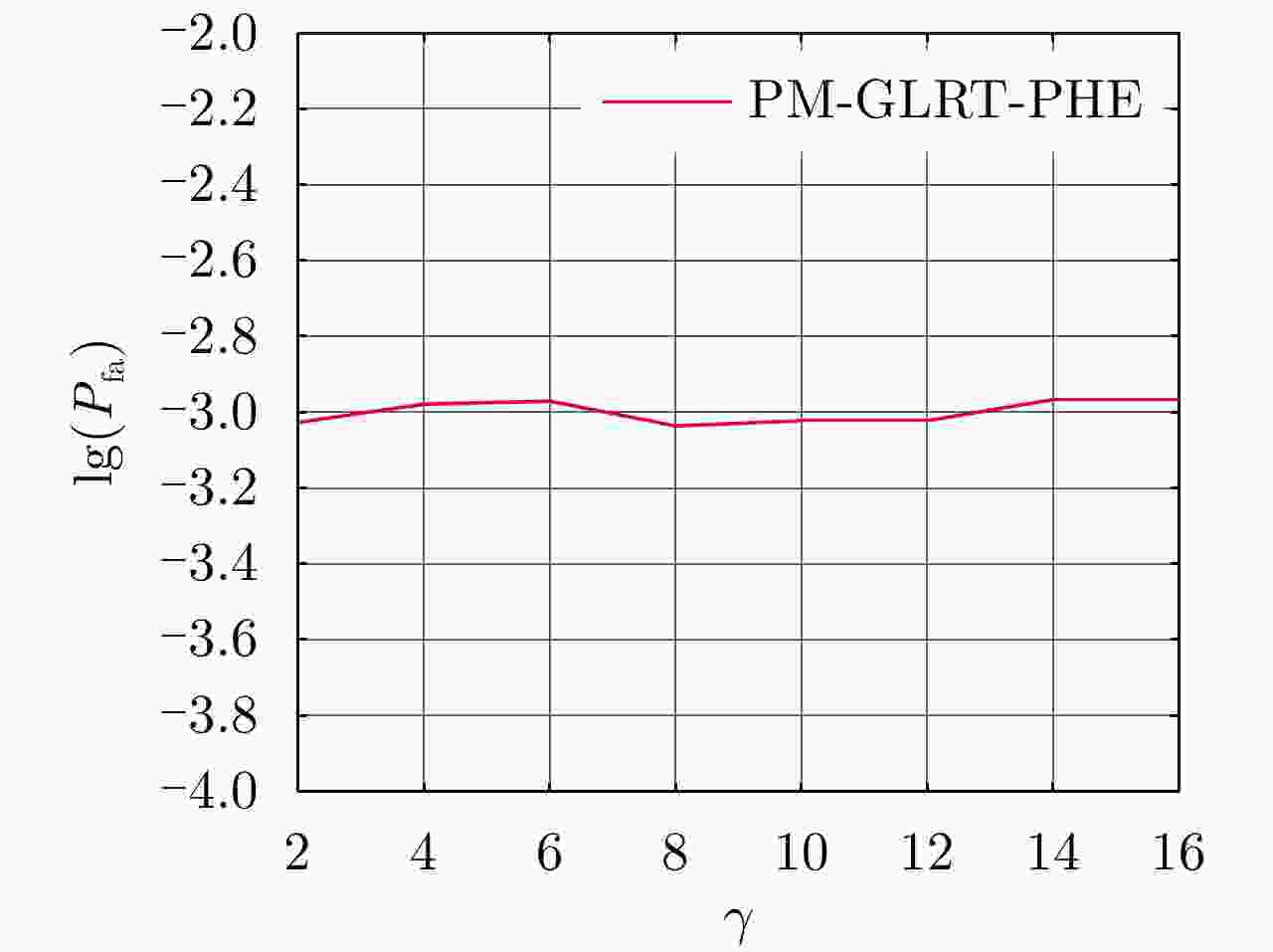




 下载:
下载:
